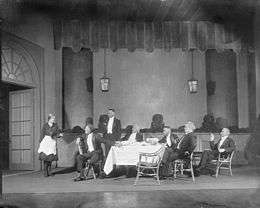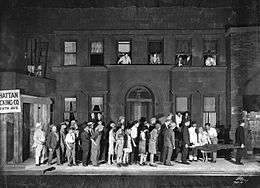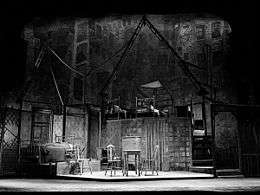Jo Mielziner
| Jo Mielziner | |
|---|---|
| Born |
March 19, 1901 Paris, France |
| Died |
March 15, 1976 (aged 74) New York City, New York, U.S. |
| Known for | Scenic design |
| Awards | Tony Award; Drama Desk Award for Outstanding Set Design; Academy Award for Best Art Direction |
Joseph "Jo" Mielziner (March 19, 1901 – March 15, 1976) was an American theatrical scenic, and lighting designer born in Paris, France. He was described as "the most successful set designer of the Golden era of Broadway", and worked on both stage plays and musicals.[1]
Career



Jo Mielziner was the son of artist Leo Mielziner, Sr. (son of a rabbi), and Ella (née Friend), a writer. Mielziner was the brother of actor-director Kenneth MacKenna.[2] He studied painting at the Art Students League and the Pennsylvania Academy of the Fine Arts.[3] His brother recruited him as a stage manager for summer stock, where Mielzener discovered his passion for scenic design. With fellowships he received from the Pennsylvania Academy, he had the opportunity to study set design in Paris, Vienna, and Berlin. Additionally, he served as an apprentice to Robert Edmond Jones, designer of Eugene O'Neill's Desire Under The Elms. [4]Mielziner was considered one of the most influential theatre designers of the 20th century,[5] designing the scenery and often the lighting for more than 200 productions, many of which became American classics. He "pioneered 'selective realism' in scenic design".[6] According to his obituary, he was perhaps "praised most often...for his sweeping canvas of people under the Brooklyn Bridge, used as a backdrop for Maxwell Anderson's Winterset.[2]
After his education and spending 13 months in Europe "absorbing the revolutionary changes occurring in traditional stage design", in 1923 he worked for the Theatre Guild in New York as an assistant stage manager and bit actor.[2] Mielziner's Broadway debut as a designer was in 1927 with The Guardsman, for which he designed the scenery and lighting.[7] His other Broadway credits include the original productions of Sweet and Low, Of Thee I Sing, Another Part of the Forest, Winterset, Oh, Captain!, Dodsworth, Strange Interlude, Carousel, South Pacific, Guys and Dolls, The King and I, A Streetcar Named Desire, Death of a Salesman, Cat on a Hot Tin Roof, Gypsy, and The Prime of Miss Jean Brodie,[8] as well as the film Picnic and the ballet Who Cares?. He won the Academy Award for best color art direction for his work on Picnic.[9]
During World War II, Mielziner worked as a camouflage specialist with the United States Air Force, until he was transferred to the Office of Strategic Services, a precursor to the CIA, where he served under General William J. "Wild Bill" Donovan.[10][11]
In the course of his career, Mielziner won seven Tony Awards and was nominated for another five.[12] He also won the Drama Desk Award for Outstanding Set Design. His influence extended outside of the theatre. He was acquainted with the American artist Edward Hopper, who is said to have modeled his well-known painting Early Sunday Morning (1930) after Mielziner's set for Elmer Rice's play Street Scene, produced in 1929.
Mielziner designed the theater at Wake Forest University[13] and co-designed the Vivian Beaumont Theater at Lincoln Center with architect Eero Saarinen.[14]
He resided for many years at The Dakota[15] and can be seen working in his studio in an exterior shot in the film Rosemary's Baby. He died on March 15, 1976, in a New York taxicab four days before his 75th birthday. He was rushing between meetings for The Baker's Wife, a musical for which he was designing.[2][4]
Personal Life
Mielziner was of both Jewish and Christian ancestries, though he converted to Roman Catholicism under the influence of Bishop Fulton J. Sheen. He was married three times, all of which were tumultuous, though only two ended in divorce. His first wife, Marya Mannes, a literary critic, was unfaithful to him. Annie Laurie Jacques, an actress and Mielziner's his second wife had problems with substance abuse. Though, as a Roman Catholic, he could not divorce his third wife, their relationship ended due to Mielziner's relationship with Sheen's private secretary.[11]
Legacy
His scenic designs for the original production of Arthur Miller's Death of a Salesman were re-created for the 2012 Broadway revival starring Academy Award winner Philip Seymour Hoffman, Andrew Garfield and Linda Emond. Director Mike Nichols stated that he felt he needed Mielziner's original set because it was "intimately connected with the way the play developed." He went on to say he has never seen anything "near as good in any of the productions of 'Salesman' because it's everything and nothing."[16]
References
- ↑ Vlastnik, Frank; Bloom, Ken.Jo Mielziner profile, Broadway Musicals: The 101 Greatest Shows of All Time, Black Dog Publishing, 2010; ISBN 1-57912-849-1, p. 261
- 1 2 3 4 Krebs, Albin.Jo Mielziner Dead at 74; Pioneering Set Designer; Dozens of Hits 'A Unique Gift' Got Traveling Scholarships Designed Theaters" The New York Times (abstract), March 16, 1976, p. 38
- ↑ "Art: Theatre Time Magazine, April 11, 1932
- 1 2 "archives.nypl.org -- Mielziner family papers". New York Public Library Archives & Manuscripts. Retrieved 2016-04-21.
- ↑ Williams, Tennessee and Thornton, Margaret Bradham."Jo Mielziner" Notebooks, p. 554
- ↑ Barranger, Milly S.Mielziner Theatre: A Way of Seeing, Cengage Learning, 2005; ISBN 0-495-00472-3, p. 258
- ↑ Atkinson, Brooks."The Play:Pasting the Medicine Men" The New York Times (abstract), November 22, 1927
- ↑ "Mielziner Broadway Credits" InternetBroadwayDatabase, accessed April 16, 2011
- ↑ "NY Times: Picnic". NY Times. Retrieved 2011-04-16.
- ↑ Wright, Charles."No Ordinary Jo -- Mielziner: Master of Modern Stage Design" theatermania.com, April 5, 2001
- 1 2 Henderson, Mary C. (2001-01-01). Mielziner: Master of Modern Stage Design. Back Stage. ISBN 9780823088232.
- ↑ "Mielziner Tony Awards, wins and nominations" broadwayworld.com, accessed April 16, 2011
- ↑ "Harold Tedford Abstract" wakespace.lib.wfu.edu, accessed April 16, 2011
- ↑ "Claire Tow Theater" www.lct.org, accessed April 16, 2011
- ↑ Birmingham, Stephen.Mielziner Life at the Dakota:New York's most unusual address, Syracuse University Press, 1996, ISBN 0-8156-0338-X, p.74
- ↑ Bloom, Julie; Huang, Jon; Piepenburg, Erik (March 1, 2012). "Life of a 'Salesman'". The New York Times.
Further reading
- Henderson, Mary C. Mielziner: Master of Modern Stage Design, Back Stage Books (2001), 320 pages, ISBN 978-0-8230-8823-2
External links
| Wikimedia Commons has media related to Jo Mielziner. |
- Jo Mielziner at the Internet Broadway Database

- Jo Mielziner at the Internet Movie Database
- Jo Mielziner designs and technical drawings, 1924-1976 held by the Billy Rose Theatre Division, New York Public Library for the Performing Arts
- Jo Mielziner papers, 1903-1976 held by the Billy Rose Theatre Division, New York Public Library for the Performing Arts
- Jules Fisher collection of Jo Mielziner designs, 1926-1969, 2003, held by the Billy Rose Theatre Division, New York Public Library for the Performing Arts
- Jo Mielziner book